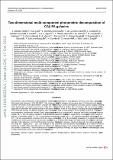Two-dimensional multi-component photometric decomposition of CALIFA galaxies
Date
02/2017Author
Grant ID
ERC-2012-StG-20111012
ST/J001651/1
Keywords
Metadata
Show full item recordAbstract
We present a two-dimensional multi-component photometric decomposition of 404 galaxies from the Calar Alto Legacy Integral Field Area Data Release 3 (CALIFA-DR3). They represent all possible galaxies with no clear signs of interaction and not strongly inclined in the final CALIFA data release. Galaxies are modelled in the g, r, and i Sloan Digital Sky Survey (SDSS) images including, when appropriate, a nuclear point source, bulge, bar, and an exponential or broken disc component. We use a human-supervised approach to determine the optimal number of structures to be included in the fit. The dataset, including the photometric parameters of the CALIFA sample, is released together with statistical errors and a visual analysis of the quality of each fit. The analysis of the photometric components reveals a clear segregation of the structural composition of galaxies with stellar mass. At high masses (log(M⋆/M⊙) > 11), the galaxy population is dominated by galaxies modelled with a single Sérsic or a bulge+disc with a bulge-to-total (B/T) luminosity ratio B/T > 0.2. At intermediate masses (9.5 < log(M⋆/M⊙) < 11), galaxies described with bulge+disc but B/T < 0.2 are preponderant, whereas, at the low mass end (log(M⋆/M⊙)< 9.5), the prevailing population is constituted by galaxies modelled with either pure discs or nuclear point sources+discs (i.e., no discernible bulge). We obtain that 57% of the volume corrected sample of disc galaxies in the CALIFA sample host a bar. This bar fraction shows a significant drop with increasing galaxy mass in the range 9.5 < log(M⋆/M⊙) < 11.5. The analyses of the extended multi-component radial profile result in a volume-corrected distribution of 62%, 28%, and 10% for the so-called Type I (pure exponential), Type II (down-bending), and Type III (up-bending) disc profiles, respectively. These fractions are in discordance with previous findings. We argue that the different methodologies used to detect the breaks are the main cause for these differences.
Citation
Mendez-Abreu , J , Ruiz-Lara , T , Sanchez-Menguiano , L , De Lorenzo-Caceres Rodriguez , A , Costantin , L , Catalan-Torrecilla , C , Florido , E , Aguerri , J A L , Bland-Hawthorn , J , Corsini , E M , Dettmar , R J , Galbany , L , Garcia-Benito , R , Marino , R A , Marquez , I , Ortega-Minakata , R A , Papaderos , P , Sanchez , S F , Sanchez-Blazquez , P , Spekkens , K , van de Ven , G , Wild , V & Ziegler , B 2017 , ' Two-dimensional multi-component photometric decomposition of CALIFA galaxies ' , Astronomy & Astrophysics , vol. 598 , A32 . https://doi.org/10.1051/0004-6361/201629525
Publication
Astronomy & Astrophysics
Status
Peer reviewed
ISSN
0004-6361Type
Journal article
Collections
Items in the St Andrews Research Repository are protected by copyright, with all rights reserved, unless otherwise indicated.
Related items
Showing items related by title, author, creator and subject.
-
SDSS-IV MaNGA: How the stellar populations of passive central galaxies depend on stellar and halo mass
Oyarzún, Grecco A.; Bundy, Kevin; Westfall, Kyle B.; Tinker, Jeremy L.; Belfiore, Francesco; Argudo-Fernández, Maria; Zheng, Zheng; Conroy, Charlie; Masters, Karen L.; Wake, David; Law, David R.; McDermid, Richard M.; Aragón-Salamanca, Alfonso; Parikh, Taniya; Yan, Renbin; Bershady, Matthew; Sánchez, Sebastián F.; Andrews, Brett H.; Fernández-Trincado, José G.; Lane, Richard R.; Bizyaev, D.; Boardman, Nicholas Fraser; Lacerna, Ivan; Brownstein, J. R.; Drory, Niv; Zhang, Kai (2022-07-06) - Journal articleWe analyze spatially resolved and co-added SDSS-IV MaNGA spectra with signal-to-noise ratio ∼100 from 2200 passive central galaxies (z ∼ 0.05) to understand how central galaxy assembly depends on stellar mass (M*) and halo ... -
Secular-and merger-built bulges in barred galaxies
Mendez Abreu, Jairo; Debattista, V. P.; Corsini, E. M.; Aguerri, J. A. L. (2014-12) - Journal articleContext. Historically, galaxy bulges were thought to be single-component objects at the center of galaxies. However, this picture is now questioned since different bulge types with different formation paths, namely classical ... -
Galaxy And Mass Assembly (GAMA) : galaxy close pairs, mergers and the future fate of stellar mass
Robotham, A. S. G.; Driver, S. P.; Davies, L. J. M.; Hopkins, A. M.; Baldry, I. K.; Agius, N. K.; Bauer, A. E.; Bland-Hawthorn, J.; Brough, S.; Brown, M. J. I.; Cluver, M.; De Propris, R.; Drinkwater, M. J.; Holwerda, B. W.; Kelvin, L. S.; Lara-Lopez, M. A.; Liske, J.; Lopez-Sanchez, A. R.; Loveday, J.; Mahajan, S.; McNaught-Roberts, T.; Moffett, A.; Norberg, P.; Obreschkow, D.; Owers, M. S.; Penny, S. J.; Pimbblet, K.; Prescott, M.; Taylor, E. N.; van Kampen, E.; Wilkins, S. M. (2014-11-11) - Journal articleWe use a highly complete subset of the Galaxy And Mass Assembly II (GAMA-II) redshift sample to fully describe the stellar mass dependence of close pairs and mergers between 10(8) and 10(12)M(circle dot). Using the analytic ...

